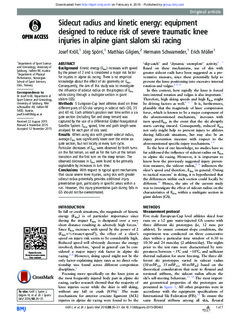| dc.contributor.author | Kröll, Josef | |
| dc.contributor.author | Spörri, Jörg | |
| dc.contributor.author | Gilgien, Matthias | |
| dc.contributor.author | Schwameder, Hermann | |
| dc.contributor.author | Müller, Erich | |
| dc.date.accessioned | 2016-04-06T08:15:24Z | |
| dc.date.available | 2016-04-06T08:15:24Z | |
| dc.date.issued | 2016-02-04 | |
| dc.identifier.citation | British Journal of Sports Medicine. 2016, 50, 26-31. | nb_NO |
| dc.identifier.uri | http://hdl.handle.net/11250/2384160 | |
| dc.description | This is an Open Access article distributed in accordance with the Creative Commons Attribution Non Commercial (CC BY-NC 4.0) license, which permits others to distribute, remix, adapt, build upon this work non-commercially, and license their derivative works on different terms, provided the original work is properly cited and the use is non-commercial. See: http://creativecommons.org/ licenses/by-nc/4.0/ | nb_NO |
| dc.description.abstract | Background: Kinetic energy (Ekin) increases with speed by the power of 2 and is considered a major risk factor for injuries in alpine ski racing. There is no empirical knowledge about the effect of ski geometry on Ekin. Consequently, the aim of this study was to investigate the influence of sidecut radius on the progress of Ekin while skiing through a multigate section in giant slalom (GS).
Methods: 5 European-Cup level athletes skied on three different pairs of GS skis varying in sidecut radii (30, 35 and 40 m). Each athlete's position over time within a six gate section (including flat and steep terrain) was captured by the use of a differential Global Navigational Satellite System. Ekin, speed, time and path length were analysed for each pair of skis used.
Results: When using skis with greater sidecut radius, average Ekin was significantly lower over the entire six gate section, but not locally at every turn cycle. Particular decreases of Ekin were observed for both turns on the flat terrain, as well as for the turn at the terrain transition and the first turn on the steep terrain. The observed decreases in Ekin were found to be primarily explainable by increases in turn time.
Conclusions: With respect to typical sport mechanisms that cause severe knee injuries, using skis with greater sidecut radius potentially provides additional injury preventative gain, particularly in specific areas within a run. However, this injury preventative gain during falls in GS should not be overestimated. | nb_NO |
| dc.language.iso | eng | nb_NO |
| dc.publisher | BMJ Publishing Group | nb_NO |
| dc.title | Sidecut radius and kinetic energy: equipment designed to reduce risk of severe traumatic knee injuries in alpine giant slalom ski racing. | nb_NO |
| dc.type | Journal article | nb_NO |
| dc.type | Peer reviewed | nb_NO |
| dc.subject.nsi | VDP::Social science: 200 | nb_NO |
| dc.subject.nsi | VDP::Social science: 200::Social science in sports: 330 | nb_NO |
| dc.subject.nsi | VDP::Social science: 200::Social science in sports: 330::Other subjects within physical education: 339 | nb_NO |
| dc.source.journal | British Journal of Sports Medicine | nb_NO |
| dc.identifier.doi | 10.1136/bjsports-2015-095463 | |
| dc.description.localcode | Seksjon for fysisk prestasjonsevne / Department of Physical Performance | nb_NO |
